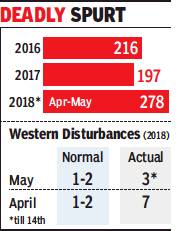Storms (dust-, hail-, rain-, thunder-): India
This is a collection of articles archived for the excellence of their content. |
The toll
2016-May 2018
Amit Bhattacharya, Storms kill more in 5 wks than all of 2017, May 15, 2018: The Times of India

From: Amit Bhattacharya, Storms kill more in 5 wks than all of 2017, May 15, 2018: The Times of India
Storms across the country have killed more people since April 11 than all of last year. Since Sunday, thunderstorms claimed 94 lives across six states, taking the death toll in storms since April to 278.
Fatalities in the first two weeks of May stand at 223, while 55 people died in April. Last year, storms claimed 197 lives, while the toll in 2016 was 216. The figures are based on numbers collated by TOI and those provided by the India Meteorological Department (IMD).
Met department scientists said the storms in north India in the past five weeks were unusual both in number and severity.
Cause of weather pattern reversal unclear
The current pattern of wind currents resembles what’s usually seen in winter months.
Outside of the monsoon season, rain and storm activity in north India take place under the influence of western disturbances, waves of air currents coming in from the Mediterranean. “We are seeing the winter pattern of western disturbances in summer this year. Ten western disturbances have affected north India in April-May, while it is usually three-four,” said M Mohapatra, director general (meteorology), IMD.
During winter, the pattern was the reverse. January, which usually gets the maximum number of western disturbances (WD) of about seven, saw just four this year. In December, when the second highest number of these disturbances rolls in, there was just one. In February, five WDs struck against a normal of six. So, the country got just 33% of its normal rainfall in January and February.
“It’s not just the number of WDs that’s important. Whether a WD makes an impact or not depends on its position and intensity. Most of the WDs during the winter months struck in a northerly position, which impacted J&K at most. In the past five weeks, WDs have come in the right direction and intensity to have a big impact,” Mohapatra said.
What caused this reversal of pattern is not clear, but the reasons probably lie in largescale weather features. Since the WDs originate around southern Europe, air currents in that region and in the Atlantic Ocean become important. “The reasons need to be studied. One factor that could be coming into play is the North Atlantic Oscillation (NAO), which is currently in the positive phase,” Mohapatra said.
See also
Cyclonic winds, cyclones: South Asia
Storms (dust-, hail-, rain-, thunder-): India